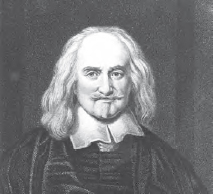Early Modern PhilosophyThomas Hobbes |
What was Thomas Hobbes life like? |
Hobbes’ father was the vicar of Westport, but he had to leave for London after his involvement in a brawl outside his church. Thomas’ uncle, the alderman of Malmesbury, financed his education. Hobbes studied Greek and Latin at Oxford University from 1602 to 1608, and after graduating he took the position of tutor to Lord Cavendish’s oldest son, William. (Lord Cavendish, Earl of Devonshire was to become Hobbes’ main patron throughout his working career.) With William, he traveled to Europe in 1610, when Johannes Kepler first published his system of the elliptical shape of planetary orbits and Galileo Galilei was reporting his observations with telescopes. Hobbes met English statesman, scientist, and philosopher Francis Bacon after he returned to England and agreed with him about the need to discard Aristotelian views of science. However, Hobbes did not subscribe to Bacon’s inductive method. Bacon believed that scientific knowledge could be built up from observation. Hobbes, in contrast, was to develop a system of knowledge beginning from the first principles of matter and motion from which the nature of experience could be deduced.
Hobbes then began reading the classics and translated Thucydides’ history into English in 1628. By this time, Sir Cavendish had died and his widow dismissed Hobbes to cut expenses. So, Hobbes went back to Europe to work for another noble family as tutor to Sir Clinton’s son. He became interested in geometry as a method for conveying a philosophical system; his interest in astronomy was piqued when he met the astronomer, priest, and philosopher Pierre Gassendi (1592–1655), as well as Galileo.
From that exchange, he conceived the idea of applying the principles of the science to the human world, specifically to politics and history. He wrote Little Treatise (1637), an explanation of sensation set out in a geometrical form, which was both an attack on Aristotle’s theory, and his own original thought. He thought that the cause of all sensation was changes in motion of insensible particles.
In 1650, Hobbes published his Elements of Law in two parts: the psychological treatise Human Nature and De Corpore Politico, which defended unified government. This began a period when Hobbes’ life was in danger as politics shifted, because he was suspected of atheism on account of his materialism and was disliked because of his own dislike of Catholics. Overall, his defense of a strong monarchy set Parliament against him. Meanwhile, he was briefly the mathematical tutor to Charles II, before he became king, and he published his magnum opus, Leviathan (1651).
Between 1645 and 1663, Hobbes became involved in several protracted and bitter controversies with other thinkers. He disputed the question of free will with John Bramwell, bishop of Derry. Two Oxford dons were angry with him: John Wallis, a professor of geometry, was scathing about Hobbes’ attempts to square the circle. (This was the problem dating from antiquity of devising a method for constructing a square with an area equal to the area of any given circle.) Seth Ward, professor of astronomy, was opposed to Hobbes’ entire philosophy.

